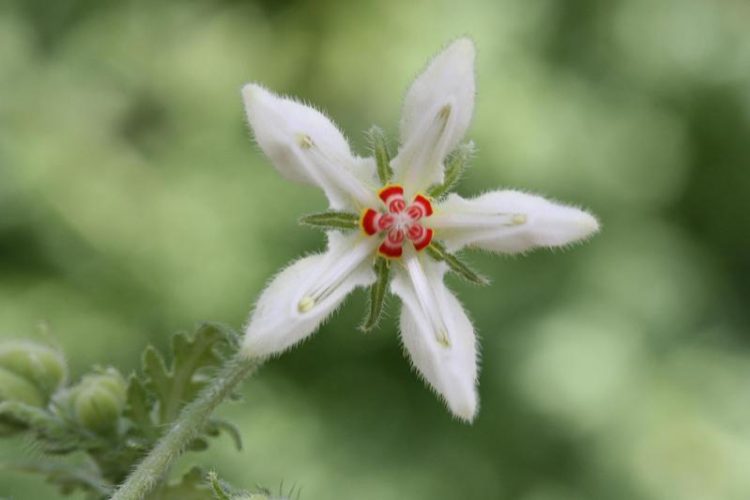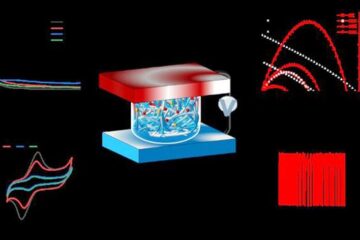Plants are „biting“ back

The colourful flower of the rock nettle Blumenbachia insignis in the Botanical Gardens of Bonn University. (c) Photo: M. Weigend/Uni Bonn
Animals only eat them once: When the tongue touches the minute trichomes of rock nettles (Loasaceae), the tips of the stinging hairs break off and a painful cocktail pours out into the sensitive tissue. These well-defended plants have their centre of diversity in the South American Andes.
„The mechanism is very similar to that of our well-known stinging nettles“, says Prof. Dr. Maximilian Weigend of the Nees-Institut for Biodiversity of Plants at Bonn University. There are additional differences between the only stinging nettles and rock nettles – which are only distantly related – apart from their different appearance: Native stinging nettles fortify their needle-like hairs with silica, while their spectacularly flowering South American counterparts employ calcium phosphate for that purpose.
Calcium phosphate has never previously been documented as a structural biomineral in higher plants. “The mineral composition of the stinging hairs is very smilar to that of human or animal teeth“ says Prof. Weigend, who has been researching the highly diverse rock nettles for the past 25 years.
Many scientists previously noted the strikingly rough hairs of this plant group, but nobody ended up researching their chemical composition. The botanists investigated the stinging hairs – built like hypodermic syringes – with their own electron microscope and in collaboration with colleagues from the Steinmann-Institute for Geology, Mineralogy and Paleontology and the Institute of Inorganic Chemistry of Bonn University.
Tips of the stinging hairs structurally similar to reinforced concrete
It could be shown that especially the mechanically highly stressed tips of the hairs are incrusted with calcium phosphate. „This is essentailly a composite material, structurally similar to reinforced concrete“, explains Prof. Weigend. The fibrous cellulose as the typical material of plant cell walls provides the scaffolding and is densely incrusted with tiny crystals of calcium phosphate. The scientist of Bonn University is convinced „This renders the stinging hairs unusually rigid”.
It is still unclear why rock nettles evolved this particular type of biomineralization, while most plants use silica or calcium carbonate as structural biominerals. „A common reason for any given solutions in evolution is that an organism possesses or lacks a particular metabolic pathway“, says Prof. Weigend. However, rock nettles are able metabolize silica and use it as a structural biomineral – side by side with calcium phosphate. It is not currently understood why it is particularly calcium phosphate that is used in the stinging hairs tips, the very substance that the mouthparts of their enemies also consist of. „At present we can only speculate about the adaptive reasons for this. But it seems that rock nettles pay back in kind – a tooth for a tooth” chuckles the biologist of Bonn University.
Bionics: plant trichomes as templates for bone substitutes
Additional research projects are directed towards investigating which other plants may use structural calcium phosphate to face challenges in their natural environment and which biomechanical advantages this material conveys to the plants. The discovery is also of potential relevance for bionic applications. „Surgical bone substitutes have to be highly tissue compatible, cellulose-composite are likely to meet that criterion“, says Prof. Weigend. First attempts at producing artificial cellulose-calcium phosphate composite have been made by other researchers, but so far a natural template was unknown. The cellulose-calcium phosphate composite in rock nettles could be just such a template.
Publication: Hans-Jürgen Ensikat, Thorsten Geisler & Maximilian Weigend: A first report of hydroxylated apatite as structural biomineral in Loasaceae – plants‘ teeth against herbivoren, Scientific Reports, DOI: 10.1038/srep26073
Media contact:
Prof. Dr. Maximilian Weigend
Nees-Institut for Biodiversity of Plants
Bonn University
Tel. ++49-(0)228-732121
Email: mweigend@uni-bonn.de
Media Contact
More Information:
http://www.uni-bonn.deAll latest news from the category: Life Sciences and Chemistry
Articles and reports from the Life Sciences and chemistry area deal with applied and basic research into modern biology, chemistry and human medicine.
Valuable information can be found on a range of life sciences fields including bacteriology, biochemistry, bionics, bioinformatics, biophysics, biotechnology, genetics, geobotany, human biology, marine biology, microbiology, molecular biology, cellular biology, zoology, bioinorganic chemistry, microchemistry and environmental chemistry.
Newest articles

Superradiant atoms could push the boundaries of how precisely time can be measured
Superradiant atoms can help us measure time more precisely than ever. In a new study, researchers from the University of Copenhagen present a new method for measuring the time interval,…

Ion thermoelectric conversion devices for near room temperature
The electrode sheet of the thermoelectric device consists of ionic hydrogel, which is sandwiched between the electrodes to form, and the Prussian blue on the electrode undergoes a redox reaction…

Zap Energy achieves 37-million-degree temperatures in a compact device
New publication reports record electron temperatures for a small-scale, sheared-flow-stabilized Z-pinch fusion device. In the nine decades since humans first produced fusion reactions, only a few fusion technologies have demonstrated…





















